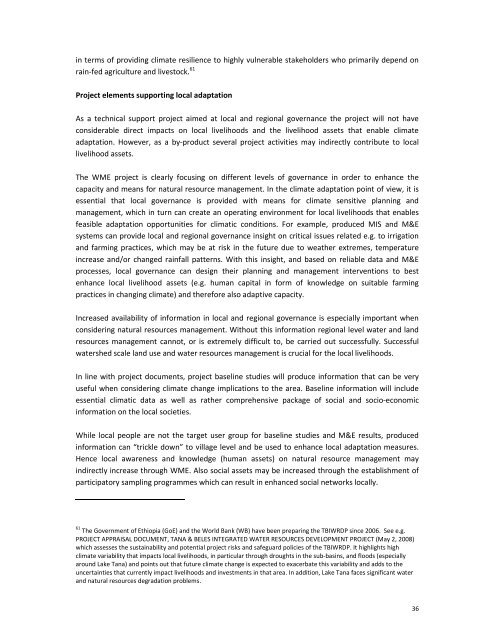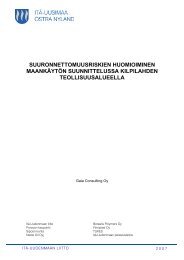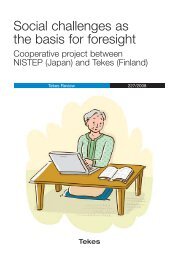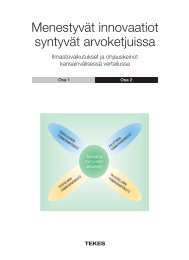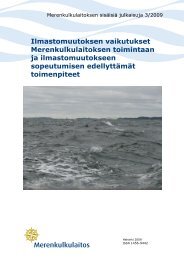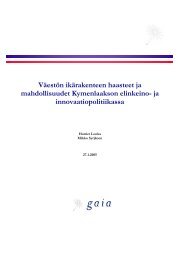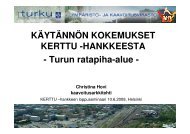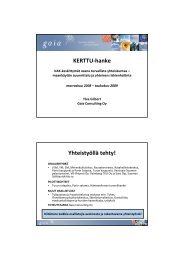Climate Risk Management in Finnish Development Cooperation - Gaia
Climate Risk Management in Finnish Development Cooperation - Gaia
Climate Risk Management in Finnish Development Cooperation - Gaia
Create successful ePaper yourself
Turn your PDF publications into a flip-book with our unique Google optimized e-Paper software.
<strong>in</strong> terms of provid<strong>in</strong>g climate resilience to highly vulnerable stakeholders who primarily depend on<br />
ra<strong>in</strong>-fed agriculture and livestock. 61<br />
Project elements support<strong>in</strong>g local adaptation<br />
As a technical support project aimed at local and regional governance the project will not have<br />
considerable direct impacts on local livelihoods and the livelihood assets that enable climate<br />
adaptation. However, as a by-product several project activities may <strong>in</strong>directly contribute to local<br />
livelihood assets.<br />
The WME project is clearly focus<strong>in</strong>g on different levels of governance <strong>in</strong> order to enhance the<br />
capacity and means for natural resource management. In the climate adaptation po<strong>in</strong>t of view, it is<br />
essential that local governance is provided with means for climate sensitive plann<strong>in</strong>g and<br />
management, which <strong>in</strong> turn can create an operat<strong>in</strong>g environment for local livelihoods that enables<br />
feasible adaptation opportunities for climatic conditions. For example, produced MIS and M&E<br />
systems can provide local and regional governance <strong>in</strong>sight on critical issues related e.g. to irrigation<br />
and farm<strong>in</strong>g practices, which may be at risk <strong>in</strong> the future due to weather extremes, temperature<br />
<strong>in</strong>crease and/or changed ra<strong>in</strong>fall patterns. With this <strong>in</strong>sight, and based on reliable data and M&E<br />
processes, local governance can design their plann<strong>in</strong>g and management <strong>in</strong>terventions to best<br />
enhance local livelihood assets (e.g. human capital <strong>in</strong> form of knowledge on suitable farm<strong>in</strong>g<br />
practices <strong>in</strong> chang<strong>in</strong>g climate) and therefore also adaptive capacity.<br />
Increased availability of <strong>in</strong>formation <strong>in</strong> local and regional governance is especially important when<br />
consider<strong>in</strong>g natural resources management. Without this <strong>in</strong>formation regional level water and land<br />
resources management cannot, or is extremely difficult to, be carried out successfully. Successful<br />
watershed scale land use and water resources management is crucial for the local livelihoods.<br />
In l<strong>in</strong>e with project documents, project basel<strong>in</strong>e studies will produce <strong>in</strong>formation that can be very<br />
useful when consider<strong>in</strong>g climate change implications to the area. Basel<strong>in</strong>e <strong>in</strong>formation will <strong>in</strong>clude<br />
essential climatic data as well as rather comprehensive package of social and socio-economic<br />
<strong>in</strong>formation on the local societies.<br />
While local people are not the target user group for basel<strong>in</strong>e studies and M&E results, produced<br />
<strong>in</strong>formation can “trickle down” to village level and be used to enhance local adaptation measures.<br />
Hence local awareness and knowledge (human assets) on natural resource management may<br />
<strong>in</strong>directly <strong>in</strong>crease through WME. Also social assets may be <strong>in</strong>creased through the establishment of<br />
participatory sampl<strong>in</strong>g programmes which can result <strong>in</strong> enhanced social networks locally.<br />
61 The Government of Ethiopia (GoE) and the World Bank (WB) have been prepar<strong>in</strong>g the TBIWRDP s<strong>in</strong>ce 2006. See e.g.<br />
PROJECT APPRAISAL DOCUMENT, TANA & BELES INTEGRATED WATER RESOURCES DEVELOPMENT PROJECT (May 2, 2008)<br />
which assesses the susta<strong>in</strong>ability and potential project risks and safeguard policies of the TBIWRDP. It highlights high<br />
climate variability that impacts local livelihoods, <strong>in</strong> particular through droughts <strong>in</strong> the sub-bas<strong>in</strong>s, and floods (especially<br />
around Lake Tana) and po<strong>in</strong>ts out that future climate change is expected to exacerbate this variability and adds to the<br />
uncerta<strong>in</strong>ties that currently impact livelihoods and <strong>in</strong>vestments <strong>in</strong> that area. In addition, Lake Tana faces significant water<br />
and natural resources degradation problems.<br />
36


